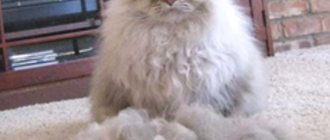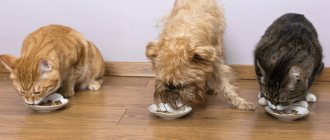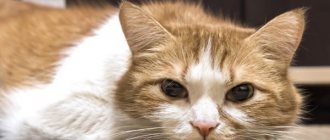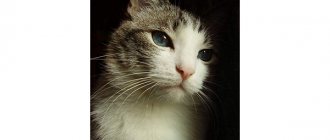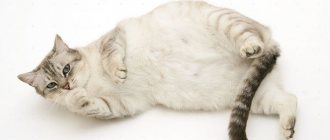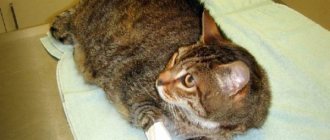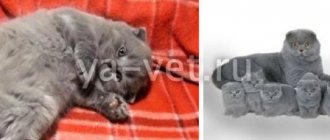Veterinary specialists regularly encounter complaints that cats often vomit hair. If this happens weekly or less often, then there is nothing to be afraid of - this is a normal process of cleansing the intestines. Repeated daily vomiting is a concern, which may indicate the development of a chronic disease or the formation of a large hairball in the stomach.
Let's find out whether you can cope with the problem yourself, and when you need urgent help from a specialist.
General Information about Hair Vomiting in Cats
From the point of view of doctors, vomiting is not a disease, but a reflex reaction of the stomach in response to an irritant. The vomiting mechanism is designed to cleanse the stomach of excess food, foreign bodies, hair, and toxic substances.
The vast majority of cat breeds have a thick coat of hair that is renewed several times a year. At the age of 6 months, kittens change their “baby” fur to adult fur for the first time (changes occur in hair structure and color).
Further, the molting process occurs individually and depends on the conditions of detention. It is during this period that cat owners begin to notice the regurgitation of “hair sausages” for the first time.
In this case, vomiting is a way to get rid of fur that has accumulated in the stomach. You should not take additional actions during this period. All you need to do is observe the frequency of vomiting and the consistency of the masses.
Vomiting hair – a physiological process or a pathology?
Regurgitation of undigested fragments is a natural physiological process in cats, which is considered their species feature.
How often a cat will vomit hair depends on the length and thickness of its coat. It has been noticed that long-haired cats get rid of hair in the stomach approximately once every 2-3 weeks, short-haired breeds - less often. It is this frequency of the gag reflex for regurgitation of fur that is considered normal.
There is no clear answer to the question of what the fur that comes out during vomiting should look like. These may be small tufts of hair in white or yellowish mucus, or cylindrical clumps of wool with particles of undigested food or grass. These growths are called trichobezoars or “hair growths.”
Vomiting with fur and drops of blood is an alarming sign. The symptom indicates the development of inflammatory processes in the esophagus (esophagitis), stomach (gastritis) or the presence of sharp foreign objects, including bones (most often large fish bones cause mechanical damage to the digestive system).
Important! The presence of parasitic worms (helminths) in hairballs that come out during vomiting indicates a helminthic infestation. This is already considered a pathology. In this case, it is urgent to deworm the cat in two stages, with an interval of 10-14 days. You should select a broad-spectrum anthelmintic drug (for round and tapeworms). Examples of effective veterinary drugs: Milbemax, Milprazone, Profender, Kanikvantel, Drontal, Pratel, Helmimax-4, Cestal cat.
Occasional nausea and vomiting may occur in animals that quickly pick up large pieces of food or eat excessive amounts of dry food. The food croquettes become saturated with gastric juice, swell, cause irritation of the stomach walls and the cat vomits.
Such pets need to grind their food or feed it often, but in small portions. Dry food should be soaked in warm water.
Causes of fur accumulation in the stomach and vomiting
All cats carefully care for their fur by licking. According to its anatomical feature, the cat's tongue is covered with small hook-shaped growths, curved back. They play the role of a “scoop” when collecting dirt from hairs.
In the process of washing, the tongue picks up the fallen hairs, they are swallowed and settle in the stomach. As a result of muscle contractions, small balls (trichobezoars) are formed from the hairs. As the fur grows, the lump occupies a significant part of the stomach, irritates its walls and the gag reflex is triggered, the cat vomits.
Cats with short hair have a certain peculiarity - after emptying the stomach, several more vomiting movements are observed. This happens because short hairs are less able to form balls and stick to the walls of the stomach, which causes repeated irritation.
However, short-haired cats (unlike long-haired cats) are less likely to shed hair. The eaten hairs usually do not stay in the stomach, but move into the intestines with portions of food and come out when the animal defecates.
The problem of frequent vomiting with hair
If a cat vomits hairballs more than once every 7 days, this is a cause for concern. The first thing you should pay attention to is whether the pet is shedding excessively. With a deficiency of vitamins and microelements, animals can constantly shed their hair.
The problem can be solved by correcting the diet, introducing effective vitamin-mineral complexes and mandatory combing at least 2-3 times a week.
Popular vitamin preparations for cats are: LavetaSuper from Beaphar (drops), Cat Felltop from Canina (gel and tablets), FeliDerm from Anivital (chewable tablets), Velcote (oil for oral administration).
Another reason for frequent vomiting of hairballs is the increased ingestion of hair by animals as a result of a pathological process.
Causes and ways to combat excessive wool eating:
| Possible reason | What to do with a cat | Treatment option |
| Allergic dermatitis with itching of the skin (occurs with food intolerance to animal protein) | Change the food to hypoallergenic (without animal protein) or with a different composition (with fish, lamb or duck) + carry out antipruritic therapy | Strict veterinary diets for cats (premium dry food): HillsZ/d, PurinaHA, Hypoallergenic from Royal Canin. For itching, give Exekan (sugar cubes) or “StopZud” |
| Flea infestation with itching, cat chews fur in clumps | Insectoacaricidal treatment of the animal (wash with flea shampoo, after 2 days treat with external drops) + disinfestation of the premises | Any antiparasitic shampoo for cats and drops for the withers, suitable for weight and age. For the room - ProtectoPlus spray from Beaphar, Neostomazan or Butox |
| Stressful condition, which is expressed by excessive licking, up to injury | Put a protective collar on the cat (purchased at pet stores), and spray pheromones in the apartment for a long time | Behavior modulator diffuser with cat pheromones FeliWay from Ceva (valid for 1 month) |
Fur can quickly accumulate in a cat's stomach due to decreased upper gastrointestinal motility. This is another reason for frequent vomiting. This process is usually accompanied by infrequent bowel movements (every few days) and constipation.
In this case, it is necessary to consult a veterinary nutritionist with a diet correction (aimed at increasing the amount of fiber and vegetables eaten). To facilitate the passage of feces through the intestines and prevent vomiting with hair, a specialist may recommend the introduction of petrolatum oil orally.
Reason #2: Inappropriate Diet
Cats may vomit due to poor quality food and biologically unacceptable ingredients in the food. Ingredients processed at ultra-high temperatures may include parts of animal carcasses such as bird feathers, beaks, hooves and claws, as well as abscesses and tumors from dead animals.
Since the invention of ultra-processed pet foods, many cats have been fed a diet that is inappropriate for their species, leading to a variety of chronic reactions, including food intolerances and allergies—a very common cause of persistent vomiting. If your cat has a normal weight and energy level and only vomits occasionally, a food sensitivity may be the cause.
Food sensitivities develop when animals with so-called leaky gut are fed the same foods over and over again, even if it is high-quality protein. Therefore, in any case, it is advisable to have a varied diet. Feeding the same type of ultra-processed protein over time can cause gastrointestinal inflammation and food sensitivities.
Article continues after advertisement
What to do? I recommend switching cats with gastrointestinal distress to a raw food diet. But even lightly cooked meat at home would be a huge improvement over an ultra-processed industrial diet.
If you feed your cat the same protein source, I also recommend changing it every three to four months to avoid hypersensitivity reactions. If you think your cat may have a food sensitivity or allergy, I also recommend taking a NutriScan saliva test to help determine the appropriate diet. Correcting food sensitivities, removing harmful and unnecessary ingredients from the diet, and switching to a raw food diet will eliminate most common causes of vomiting in cats.
If you occasionally give your cat treats, make sure they are of high quality. Better yet, make a homemade treat. You don’t want to first establish a diet with such difficulty, and then neutralize all the improvements in well-being by treating you to inappropriate treats. After all, any chemical additives and preservatives can cause inflammation of the gastrointestinal tract and vomiting.
It is also important to note that, contrary to what many people believe, cats do not need milk. Drinking milk after weaning can cause or worsen inflammation of the gastrointestinal tract. If your cat cannot tolerate cow's milk, it may cause her to vomit.
Associated symptoms with vomiting hair
If a cat repeatedly vomits hair, you should take a closer look at the condition of the animal and assess the presence of alarming symptoms (lethargic condition, complete or partial refusal of favorite food, drinking too much, lack of interest in communication, prolonged sleep, rare urination, diarrhea, changes in body temperature , discharge from the eyes or nose, signs of a cold).
Combinations of these signs along with frequent vomiting with hair are a reason for an urgent visit to the veterinarian.
If the cause of vomiting is large trichobezoars that cannot leave the stomach (too dense and large hair ball), and the cat is young and healthy, then the symptoms may be as follows:
- the cat eats often, but in small portions;
- is constantly near the bowl (there is a feeling of hunger against the backdrop of a full stomach);
- deterioration of coat quality;
- frequent urge to vomit;
- cough;
- weight loss.
If you experience such alarming symptoms, you should not self-medicate with Vaseline or vegetable oil, as the hairball may slip into the intestines and cause a blockage. The right decision is an urgent consultation with a veterinarian.
Preventive measures
To prevent the problem, you should follow simple preventive measures. The basic rule is to brush your pet regularly. For long-haired breeds, it is recommended to carry out the procedure at least once a day, especially during the molting period. It is better to get used to combing from childhood - the pet will get used to it and will be calm about the ritual.
It is also recommended to plant a special grass, the seeds of which can be purchased at a pet store or veterinary pharmacy. Regular consumption of greens helps remove hair from the intestines, normalize the functioning of the digestive tract, and replenish the lack of vitamins or minerals in the body. Veterinarians also recommend introducing a special food into the diet, the formula of which contains elements that effectively cleanse the digestive organs.
Be sure to provide your cat with access to clean water. Fresh liquid activates the digestive processes and prevents the formation of large, dense hairballs. Drinking water regularly will also help prevent intestinal blockages or stomach problems.
If a pet regularly regurgitates, owners are advised to carefully monitor the pet for several days - if there are no additional symptoms of disorders, there is no particular reason to panic. If your cat spits up hair every other day or even more often, it is better not to neglect the help of a veterinarian.
What happens if a hairball gets into a cat's intestines?
If the trichobezoar is small and has advanced into the intestine, then with good peristalsis it will be released naturally, with feces, without any unpleasant consequences.
If the hairball is sufficiently dense and large, then blockage of the intestinal lumen may occur, which is clinically expressed as constipation, abdominal pain, lethargy and apathy. The cat experiences discomfort and stops eating and playing.
Due to blockage, the intestinal walls become inflamed, and blood may appear when attempting to defecate or in small amounts of stool.
In such situations, it is necessary to give the cat at least 20 ml of Vaseline oil, and if the animal does not go “big” within 24 hours, you need to go to the veterinary clinic. The doctor will conduct an examination, determine the location of the problem and prescribe appropriate treatment.
In rare cases, surgical removal of conglomerate from wool is prescribed.
Important! A cat with a complete blockage of the intestinal lumen will die in a few days without veterinary care, so you can’t hesitate!
Presence of undigested food in vomit
There are several reasons for the appearance of such symptoms. Among the most common are the following:
- Rapid absorption of food, overeating.
- Poor quality food. If there is a lack of protein in the feed, the absorption of nutrients slows down. The meat content in cheap feeds is only about 3%. The lack of protein is compensated by adding offal; it is also possible that there are chemicals in the composition, all of which can cause vomiting.
- Poisoning.
- Infectious diseases.
- Pancreatitis, colitis, gastritis.
- Intestinal inflammation.
- Helminthic infestations.
Treatment and prevention of hair vomiting in cats
Common methods of treating cats with hair vomiting:
- Internal administration of petroleum jelly. It has a laxative effect by softening the intestinal contents and stimulating the motility of the digestive tract, as a result of which the cat has bowel movements faster and easier. In this case, the drug is not absorbed (does not affect the functioning of the liver and pancreas), but leaves the body along with the animal’s feces. A single dose of the drug equal to 10 ml (forcefully injected into the mouth from a syringe without a needle) is considered prophylactic. For frequent constipation, a cat can be given up to 20 ml of oil for no more than 5 days. Next, you should replace the product with human drugs "Duphalac" (inside), microenema "Microlax" (in the rectum) or Lactusan (inside).
- Endoscopic hairball removal. This is a non-surgical method, it is used in veterinary clinics that are equipped with modern flexible endoscopes. Under ultrasound control, the doctor determines the location where the hair conglomerate is located. The cat is put under anesthesia, then the doctor uses a special device through the oral cavity to remove hair from the gastrointestinal tract.
- Abdominal surgery: the trichobezoar is surgically removed. Doctors often have to remove part of the intestine due to severe inflammation or tissue death.
As preventative measures to prevent vomiting with hair, it is optimal to use:
- special malt pastes for cats and ferrets;
- offer cats fresh grass (sprouted wheat or oats);
- periodically introduce a few drops of vegetable or fish oil into the animal’s diet;
- with natural feeding, increase the proportion of vegetables or dry fiber (purchased in pharmacies);
- Brush the cat during periods of heavy shedding and bathe it once (every few months).
Combing
Brushing is an incredibly pleasant and beneficial procedure for cats. It is recommended to carry it out from a young age in order to accustom the animal to a comb. Upon completion of the process, the cat should be treated to its favorite treat (this will consolidate the positive result).
Suitable accessories for combing are: combs without balls on the teeth (this prevents healthy hair from being torn out), rubber gloves (with a massage effect), cat slickers, furminators (unique trimmers that comb out the undercoat).
How to properly brush a cat:
- pet the pet;
- lay the cat on its side;
- carry out several combing movements in the direction of hair growth (from head to tail);
- turn the cat over on the other side and repeat;
- put the animal on its paws or sit it on the owner’s lap, comb the back, head, neck, tail;
- turn the cat over on its back and brush its belly.
Regular brushing (once a week) reduces the amount of hair ingested and therefore reduces the likelihood of vomiting.
Proper diet and feeding regimen for cats to prevent hair vomiting
A well-designed cat diet is half the success in the fight and prevention of various gastrointestinal diseases, including frequent vomiting. Today, the pet supply market is replete with a wide range of complete cat foods of various classes, including special diets labeled “hair removal.”
A special feature of the formulation of wool-breeding feeds is the increased content of plant fiber, prebiotics, and oils. Some brands add ingredients that can reduce the length of time animals shed. It is these foods that are best purchased for cats with a tendency to frequently vomit hair.
If the cat is on natural feeding or table food, then meat fibers and fiber from vegetables help move hair through the intestines.
A few more tips to prevent hair vomiting in your cat:
- you need to select food with small croquettes - the larger the granules, the longer the food will move through the gastrointestinal tract;
- You should not pour a full bowl of dry food to a hungry cat, it is better to do this often and in small portions (if the cat overeats, it may vomit some of the food immediately after swallowing);
- If necessary, give the cat Vaseline oil; it must be administered on an empty stomach so as not to reduce the absorption of fat-soluble vitamins from food.
How to help your pet
Your doctor should tell you what to do if such problems arise.
It is important to identify the exact cause of vomiting . Therapy is carried out using medications. Traditional recipes can also be effective.
Preparations for removing hair from the body
Veterinary pharmacies sell special pastes that help remove hair from the stomach before lumps form, i.e. until the stage when digestive problems begin to develop.
The drugs are given strictly according to the instructions, they help:
- relieve your pet from nausea, constipation, intestinal blockage;
- eliminate loss of appetite;
- strengthen the coat, make it smooth and shiny.
Traditional methods
Folk methods will help to cope with the problem. Vaseline oil is used. Take 4 ml of the product into a syringe and pour it into the cat’s mouth in small portions.
It is important that the pet has time to swallow each portion. Due to this, the intestines are cleansed.
You can add 3-4 drops of fish oil or flaxseed oil to the food. These products also promote natural hair removal from the body.
Veterinary pharmacies and specialty pet stores sell grass seeds that can be grown at home as a houseplant.
It contains many vitamins and nutrients that a cat needs for development and normal life. When it is eaten, the animal’s stomach is cleansed of accumulated lumps.
